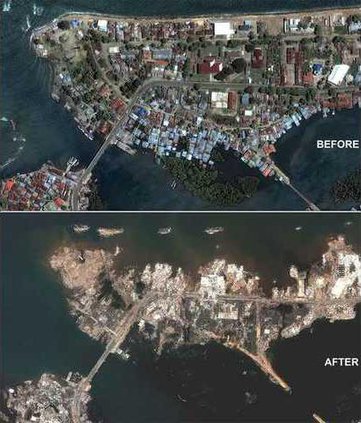Each week we’ll take a step back into the history of Great Bend through the eyes of reporters past. We’ll reacquaint you with what went into creating the Great Bend of today, and do our best to update you on what “the rest of the story” turned out to be.
The day after Christmas, 10 years ago, a tsunami in the Indian ocean killed at least 200,000 people as giant waves swept onto the shores of several islands, forever changing the lives of natives and vacationers alike. Weeks later, countries from throughout that region met in Japan and created the Hyogo Framework for Action, from which the Indian Ocean Tsunami Warning System was created. In 2011, following a 9.0 magnitude earthquake off the coast of Japan, the system was triggered, giving people along the coasts of Japan and the U.S. West coast, and everything in between, about an hour before tidal waves, some reported as high as 30 feet, rolled in. In 2012, the system gave early warnings within eight minutes of a major Indonesian earthquake, which potentially saved thousands of lives. The Hyogo Framework expires this year, and countries will once again meet to create another 10 year plan.
Hometown man stays to help
Closer to home, former USD 428 board member Jean Cavanaugh waited and prayed for word from her son, Jimmy Cavanaugh, a 1976 Great Bend High School graduate. While she and two of her sons spent the holidays in Florida, Jimmy had traveled with 16 others for a biking vacation in Thailand, arriving a few weeks before Dec. 26. The Jan. 2, 2005 Great Bend Tribune carried the good news that he had contacted his brother via email from the Bangkok airport. He was safe.
A few days later, readers learned more of the ongoing story through Cavanaugh’s friend, Bill McKown. The two had been in communication via the internet. Cavanaugh and friends were on a small island, KoaPoda, just off the Thailand shore, he wrote, when the tsunami hit.
“The beach we were on was narrow, perhaps 15 feet wide with water on one side and jagged cliffs on the other. We are alive because we had time, although well less than 10 seconds after seeing the wall of water approaching, to scramble up some rocks and wrap ourselves around a tree. We were probably 12 feet above ground level but the water still rushed around our legs. It’s power was incredible. We watched, helplessly, as boats swept past us, overturned and those in them never resurfaced.”
Cavanaugh went on to write of the retreating and advancing waves that followed, rescues by helicopter and boat, his decision to cancel his flight and stay to help in a regional hospital along with several other volunteers that had themselves been tourists days before.
Cavanaugh is listed as a lawyer in the Portland, Ore., area. According to his profile, he continues to be an avid cyclist, rafter, diver and photographer.
Cold case still unsolved
Tribune reporter Susan Thacker reminded readers of a murder case, then 18 years unsolved, that family members and authorities still hoped would be solved one day.
“The case is still on the books. A few years ago, information from the files was shared with the Kansas Bureau of Investigation’s “cold case squad.” Even with fresh eyes poring over the evidence and new leads that developed in 2001, police are no closer to solving the mystery,” she wrote.
It was Jan. 7, 1987, when Klotz was reported missing. The 30-year old mother of two daughters, ages 10 and 12, tucked them into bed the night before, and was missing the next morning. It would be four days before her boyfriend would discover her body, hidden in a closet, asphyxiation being determined the cause of death.
Another decade has passed, and still there is no resolution to the case. Then, as now, any information that could assist authorities in their investigation would be welcomed, and can be given anonymously through Crimestoppers or by contacting police directly.
School funding
Editorials and stories filled the pages of the Tribune following the Kansas Supreme Court’s ruling that education was underfunded by the state. Legislators were given three months to come up with a plan to correct the problem. According to then State Representative Ruth Teichman, legislators couldn’t agree if funds needed to be redistributed better throughout the state, or if more money needed to be thrown at the problem.
In the end, legislators did agree to appropriate more money to education, but the increase was short lived. As the nation fell into the Great Recession, the state cut funding, claiming that it had no choice because revenues were down. However, no significant increases came after the recession ended and the state began to see signs of growth again. Instead, tax cuts intended to encourage growth in the business sector were made, leading to more lawsuits by education advocates, and the state finds itself in a similar situation today.
In 2005, superintendents in the county were asked their opinions of the ruling. All welcomed the possibility of more funding, but surrounding areas believed it would come in the form of weighting for at-risk and bilingual students, which would help Great Bend more than Hoisington, Ellinwood and Claflin.
Tsunami, cold case, school funding in 2005





